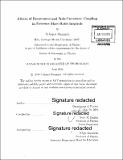| dc.contributor.advisor | Scott A. Hughes. | en_US |
| dc.contributor.author | Ruangsri, Uchupol | en_US |
| dc.contributor.other | Massachusetts Institute of Technology. Department of Physics. | en_US |
| dc.date.accessioned | 2016-09-30T19:34:13Z | |
| dc.date.available | 2016-09-30T19:34:13Z | |
| dc.date.copyright | 2016 | en_US |
| dc.date.issued | 2016 | en_US |
| dc.identifier.uri | http://hdl.handle.net/1721.1/104532 | |
| dc.description | Thesis: Ph. D., Massachusetts Institute of Technology, Department of Physics, 2016. | en_US |
| dc.description | Cataloged from PDF version of thesis. | en_US |
| dc.description | Includes bibliographical references. | en_US |
| dc.description.abstract | Since Einstein proposed the theory of general relativity (GR) as a theory of gravity, it has passed all experimental checks and tests. Until recently, all of these tests have been done in the weak gravity limit. The first test of strong-field GR came just a few months ago, when the LIGO collaboration directly detected gravitational waves for the first time. Using gravitational waves as a tool to test the validity of GR requires us to know the waveforms that GR predicts from various sources. The ultimate goal of the research described in this thesis is to compute the waveform generated by a stellar mass Kerr black hole as it inspirals into a much more massive black hole (SMBH). To compute this waveform, we must first compute the inspiral trajectory of the stellar mass black hole. The trajectory of the smaller black hole differs from the geodesic structure taught in GR textbooks due to the influence of this body's mass and spin. In this thesis, I examine these two effects separately. Later work will need to consider the two effects simultaneously, but the separate impact of these effects provides insight which helps us to understand how to model these sources. The small body's mass perturbs the spacetime and pushes its trajectory away from textbook geodesic motion. I show how to compute the dissipative part of this "self force," whose average impact is equivalent to the loss of energy and angular momentum due to gravitational wave emission. I study in particular how the self force's averaged behavior changes near orbital resonances, quantifying the impact that such resonances will have on the small body's inspiral. The small body's spin couples to spacetime curvature. This coupling leads to a force which also pushes the small body's trajectory away from the geodesic. This force is comparable in magnitude to the self force associated with the small body's mass, indicating that future work will need to assess the impact of these effects together in a self consistent way in order to make accurate inspiral waveforms. | en_US |
| dc.description.statementofresponsibility | by Uchupol Ruangsri. | en_US |
| dc.format.extent | 380 pages | en_US |
| dc.language.iso | eng | en_US |
| dc.publisher | Massachusetts Institute of Technology | en_US |
| dc.rights | M.I.T. theses are protected by copyright. They may be viewed from this source for any purpose, but reproduction or distribution in any format is prohibited without written permission. See provided URL for inquiries about permission. | en_US |
| dc.rights.uri | http://dspace.mit.edu/handle/1721.1/7582 | en_US |
| dc.subject | Physics. | en_US |
| dc.title | Effects of resonances and spin-curvature coupling in extreme mass ratio inspirals | en_US |
| dc.type | Thesis | en_US |
| dc.description.degree | Ph. D. | en_US |
| dc.contributor.department | Massachusetts Institute of Technology. Department of Physics | |
| dc.identifier.oclc | 958299685 | en_US |
